Learn how to adopt the standard bad debt process in SAP ERP Financials to ensure better integration to original items, better reporting, and more accurate provisioning as per various regulatory needs.
Key Concept
The bad debt process is a standard SAP functionality that allows you to do provisioning on the customer overdue items that are not likely to be recovered. It enables the tracking of such open items separately by using a special general ledger indicator, and also books the likely provision under an expense account in timely manner to avoid the sudden impact on a profit and loss account owing to a customer’s nonpayment.
Nearly all organizations have account receivables (customers), and there is always a risk of customers not paying their outstanding amount for invoices on time or even not paying anything at all. Therefore, companies need to make necessary provisions for such overdue items that are likely to be irrecoverable. Companies need to make these provisions to comply with various regulations such as the Sarbanes-Oxley Act and International Financial Reporting Standards (IFRS).
In this article, I cover enhancements to a standard SAP system for the following scenarios:
- How to ensure the proper profit center splitting during the transfer of doubtful items
- How to ensure consistency between original and new documents
- How to influence the treatment of credit items and the options available
- How to influence the treatment of payment for and write-offs of doubtful items
Before describing these scenarios, I first show you the steps for the standard process for bad debt in an SAP system. To complete a standard bad debt process in an SAP system, execute transaction code F103: menu > Accounting > Financial Accounting > Customers > Periodic Processing > Closing > Valuate > F103 - Receivables Transfer Posting (Gross). This process reclassifies all overdue invoices and credit memos to a target reconciliation account using a special general ledger (G/L) indicator (standard special G/L indicator = E).
Note
The standard bad debt process does not reduce the outstanding customer line items, but rather transfers the open item from a normal open item to an open item with a special G/L indicator having an alternative reconciliation account.
For more information about the standard SAP process for bad debt provisioning, see the SAPexperts Financials articles “Improve Your Bad Debt Risk Reporting” and “Make Your Bad Debt Reporting Accurate and IFRS Compliant.”
When you execute transaction F104 and follow menu path > Accounting > Financial Accounting > Customers > Periodic Processing > Closing > Valuate > F104 - Reserve for Bad Debt (Gross), you make a provision for invoices reclassified in transaction code F103 according to the percentage defined in the system as per your bad debt policy.
Now I explain the details of various scenarios to enhance the SAP standard process for bad debt provisioning.
1. How to Ensure the Proper Profit Center Splitting During the Transfer of Doubtful Items
It is quite common for customer invoices to have different profit centers in the same document. The original customer items in the document are split into respective profit centers if document splitting is active using the SAP General Ledger. In Figure 1, the customer line item is split into two line items based on the profit centers of lines 2 and line 3.

Figure 1
An original customer item showing profit center splitting
In a standard SAP system, the Document Type of the Posting is defaulted in transaction code F103 as DA (Figure 2).

Figure 2
The Posting parameters screen showing the default document type DA
If you execute transaction code F103 with this document type DA, the transfer posting document created from transaction code F103 does not have the profit center splitting for the new open item for the special G/L indicator. Instead, the transfer posting document fills the default profit center (which is assigned in customization) as shown in Figure 3. (When no default profit center is assigned in customization, the error message GLT2 201 “Balancing field &1 in line item &2 not filled appears”, and the document cannot be posted.)

Figure 3
A new transfer posting using document type DA
Therefore, the use of document type DA creates a problem in profit center reporting for the customer line items. For normal transactions with document type DA, the SAP system uses an active splitting method, and information does not need to be derived from any previous document. For payments, document type DZ is used. DZ is also configured for passive splitting with business transaction 1010 and variant 0001, but you cannot use DZ because the posting by transaction code F103 is not really a payment. To solve this issue, you need to configure the following customization settings:
In customization transaction OBA7 (SPRO > Financial Accounting (New) > Financial Accounting Basic Settings (New) > Document > Document Types > Define Document Types for Entry View), create a new document type by copying standard document type DA (e.g., a new custom document type Y1 as shown in Figure 4).
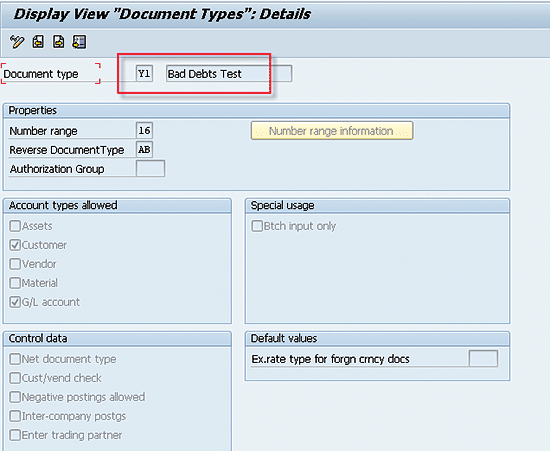
Figure 4
Create a new document type as a copy of the standard DA in customization transaction OBA7
Note
You would also need to make a setting for local ledgers for this new document type, if any non-leading ledger also is active.
In customization transaction GSP_VZ3 (SPRO > Financial Accounting (New) > General Ledger Accounting (New) > Business Transactions > Document Splitting > Classify Document Types for Document Splitting), assign the above created document type to business transaction 1010 and variant 0001 (Figure 5). This step enables the passive document splitting for the document posted by transaction code F103, and the profit center split is correctly transferred from the original customer line item to the new transfer posting. This step ensures that the splitting characteristic of the original document is transferred to the transfer posting created in transaction code F103.
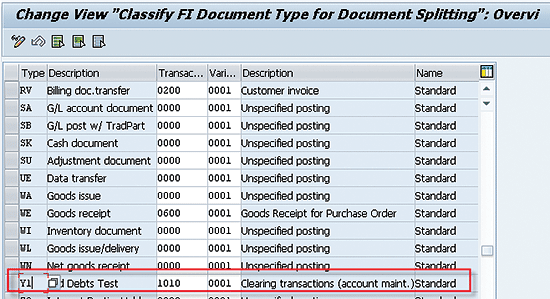
Figure 5
Link the new document type for document splitting in customization transaction GSP_VZ3
Now if you execute the transaction F103 with this new document type Y1, the transfer posting document created from transaction F103 has the proper profit center splitting as shown in Figure 6, ensuring that the original split is carried forward for new items and keeping reporting consistent.

Figure 6
A new transfer posting using new document type Y1 in transaction F103
Also during provisioning in transaction F104, the same profit center split is carried forward to the provision account as shown in Figure 7. For an expense account the profit center is derived based on the cost object assignment to the expense account.

Figure 7
Provisioning posting in transaction F104
Note
This concept of using a special document type for proper profit center splitting is derived from SAP Note 944238 (
https://service.sap.com/sap/support/notes/944238). In my example I have used the profit center to show the concept. However, this setting also ensures that the document splitting is properly done for other splitting characteristics such as segment.
2. How to Ensure Consistency Between Original and New Documents
Note that this bad debt provision is internal within the organization and customers should not know about such provisioning for the amount likely to be irrecoverable. All correspondence or other communication to customers still needs to contain the information based on the original open item so that there is no change from the customer’s point of view. The customers can still trace back the original invoices based on the account statements generated after provisioning for bad debts. Therefore, it is necessary for the transfer postings created from transaction F103 to still contain various types of information (e.g., document date, invoice reference, and amounts e) from original line items. In a standard SAP system, most of this original line-item data already has been copied to new postings created by transaction F103.
Document Date
Generally, the document date is the date when an invoice is issued to the customer. Customers can post the invoice in their books taking this document date into consideration. Therefore, the new transfer posting created from transaction F103 needs to have the same document date as the original document. When you generate the customer statement, it shows the open items that are now the new line items with a special G/L indicator. Even then the customer statement still shows the document date as in the original line item because it is also the same in the new line items with a special G/L indicator.
To enable this feature, you need to implement SAP Note 392221 (https://service.sap.com/sap/support/notes/392221). Then a new option (Use original document date) appears on the selection screen of transaction F103 (Figure 8).
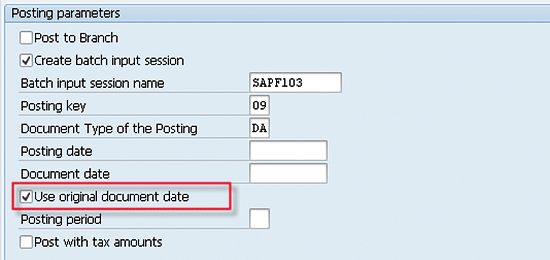
Figure 8
New option enabled in transaction F103 after applying SAP Note 392221
If you select the Use original document date field, the transfer posting takes the document date from the original item. Otherwise, the transfer posting takes the document date as entered on the selection screen of transaction F103.
Reference to Original Document in New Transfer Postings
A standard SAP system stores the original customer item information (document number, line-item number, and fiscal year) in the assignment field of the line items of the transfer postings created from transaction F103 and the provision created from transaction F104. However, you might be interested in seeing the original line-item information in the header of the document so that you can analyze the link to the original line item even in the document list display. Also, when you build custom logic to read database tables, the selection query on the header database table (BKPF) is faster than a query on line-item tables (e.g., BSEG). The postings created from transaction F104 also do not have any information about the customer to which the provision belongs unless you navigate back to the original document.
Implement SAP Note 582442 (https://service.sap.com/sap/support/notes/582442) to meet these needs. After you implement this note, you notice the following changes:
- For the transfer posting document created from transaction F103, the Document Header Text field (BKPF-BKTXT) = original document information (document number, line-item number, and fiscal year) (due to SAP Note 582442)
- Assignment field (BSEG-ZUONR) in each line item = original document information (document number, line-item number, and fiscal year)
- Special G/L assignment field (BSEG-HZUON) of special G/L line item = original document number
- For provision documents created from transaction F104, the document header text field (BKPF-BKTXT) = original document information (document number, line item number, and fiscal year)
- Assignment field (BSEG-ZUONR) in each line item = customer number
Amounts from Original Items
A standard SAP system transfers the same amount in document currency and local currency as exists in the original item.
However, you might have defined the second local currency and third local currency in customization transaction OB22: SPRO > Financial Accounting (New) > Financial Accounting Basic Settings (New) > Ledgers > Ledger > Define Currencies of Leading Ledger. If this is the case, to enable transfer of the same amount in local currencies 2 and 3 to the transfer document created via transaction F103, you need to implement the following SAP Notes:
- 1758333 https://service.sap.com/sap/support/notes/1758333
- 1829536 https://service.sap.com/sap/support/notes/1829536
- 1813210 https://service.sap.com/sap/support/notes/1813210
Implementing these three SAP Notes ensures that the same amounts are transferred to new documents and thus there is no foreign currency valuation impact created by these new postings.
Other Fields from Original Items
SAP provides SAP Note 551975 (https://service.sap.com/sap/support/notes/551975) to enable you to copy other fields from original items to transfer postings created in transaction F103.
This SAP Note demonstrates the field Payment Reference (KIDNO), but the same concept can be applied for other fields such as the following:
- Business partner reference key (XREF1)
- Business partner reference key (XREF2)
- Reference key for line item (XREF3)
- Number of the Invoice the Transaction Belongs to (REBZG)
- Fiscal Year of the Relevant Invoice (for Credit Memo) (REBZJ)
- Line Item in the Relevant Invoice (REBZZ)
3. How to Influence the Treatment of Credit Items and Various Options
The SAP system makes the transfer postings in transaction F103 for a customer only when the net balance is positive after considering the credit items such as payments or credit notes. However, a standard SAP system provides various options to calculate the percentage for provision for these credit items in transaction F104. Generally, the moderate strategy explained in Table 1 is suitable for most of the organizations. However, some organizations may prefer other strategies.
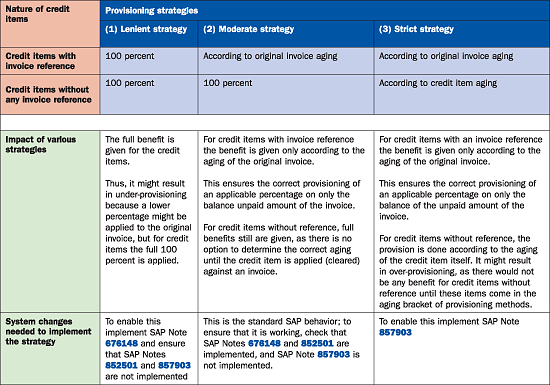
Table 1
Various options to make provision for credit items
4. How to Influence the Treatment of Payment for and Write-Offs of Doubtful Items
Now once the customer item is marked as a doubtful item (and thus a transfer posting is made to a special G/L indicator via transaction F103), the next issue is what happens if that customer has fully paid, partially paid, or not paid the overdue item.
During transaction F104, in the case of cleared items (payments or write-offs) that contain a provision that is smaller than 100 percent, the standard SAP system reverses the provision. In such cases, it is assumed that the original item has already been paid because the SAP system uses the 100 percent as an end flag and treats it as a written-off item. The SAP system does not have any way to determine whether the clearing of such an item is a write-off or a payment.
However, in this case the problem occurs when for customer items already provisioned for 100 percent, the customer makes a full payment or that item is totally written off. In such a case the earlier provision is not reversed as the standard SAP system reverses only if the original provision is smaller than 100 percent. In the case of a write-off, this behavior is still satisfactory, as the amount is still to be booked under a bad debt expense account, but for full payment scenario, the earlier provision needs to be reversed as there is no need to book the bad debt expense.
To meet this objective, you need to follow this process:
- Make system changes (I describe these changes in the next section) to enable the reversal of provision during transaction F104 in all cases of clearing items (full payment, partial payment, and write-off).
- For payments (full or partial), the reversal of the earlier provision in F104 is sufficient and no more action needed.
- For the write-off of the customer item, the contra account to be posted during write-off needs to be the bad debt expense account. For the write-off case, the provision that is reversed in the F104 is still booked into the bad debt expense account.
System Changes Needed to Enable Reversal of Provision in All Cases
To enable this feature, there are two options mentioned in SAP Note 319803 (https://service.sap.com/sap/support/notes/319803):
Option 1: In the customization transaction OB04, SPRO > Financial Accounting (New) > Accounts Receivable and Accounts Payable > Business Transactions > Closing > Valuate > Reserve for Bad Debt > Define Methods, define the maximum amount of the provision as 99 percent instead of 100 percent. Then during transaction F104, the SAP system always reverses the provisioning for all the cleared items, as original items are always provisioned at less than 100 percent owing to this provisioning method definition. However, I do not recommend this approach because it results in the bad debt under-provisioning by 1 percent and auditors can object to this approach.
Option 2: Make the source code corrections as given by SAP in SAP Note 319803 (https://service.sap.com/sap/support/notes/319803). Then, also during transaction F104, the SAP system always reverses the provisioning for all the cleared items. This option is preferred over the first option as here the original provisioning can be made up to 100 percent and even then system reverses the provisioning for cleared items.
During execution of transaction F104, you can mention the date range for the clearing date, as shown in Figure 9, so that the SAP system reverses the provision only for the items cleared during this period. Make sure that the Clearing date range end date is not beyond the date in the Open items at key date field.
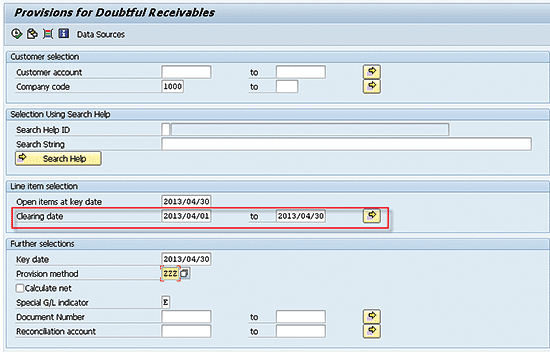
Figure 9
Select cleared items for which provisions should be reversed in transaction F104
You now understand the various options available to make the SAP bad debt process work as per your needs. These options ensure better integration to original items, better reporting, and more accurate provisioning in accordance with various regulatory needs.
Gaurav Agarwal
Gaurav Aggarwal is SAP S/4HANA lead consultant at Infosys Limited. He has more than 14 years of experience, including 11 years in SAP Finance. He has expertise in both SAP FI and Controlling (CO) with integration to other modules in manufacturing and process industries. He is a chartered accountant and SAP Certified Financial Consultant. He holds a bachelor’s degree in commerce and is a techno-functional expert with thorough knowledge of the necessary ABAP for functional experts. He is a veteran in G/L, AR, AP, banking, FA, Travel Management, and closing cockpit and has handled greenfield implementation, upgrades and conversions, rollouts, and support projects.
You may contact the author at gka2707@gmail.com.
If you have comments about this article or publication, or would like to submit an article idea, please contact the editor.














